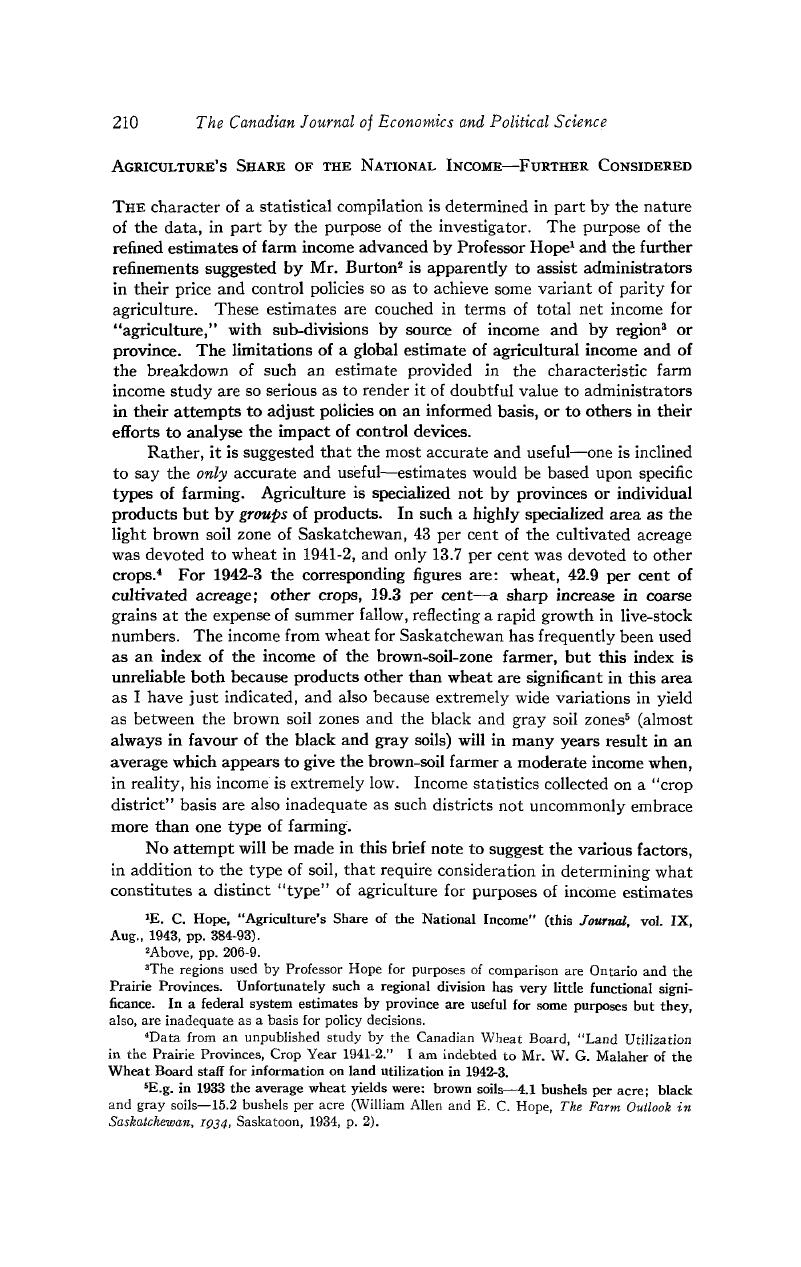Article contents
Agriculture's Share of the National Income—Further Considered
Published online by Cambridge University Press: 07 November 2014
Abstract

- Type
- Notes and Memoranda
- Information
- Canadian Journal of Economics and Political Science/Revue canadienne de economiques et science politique , Volume 10 , Issue 2 , May 1944 , pp. 210 - 212
- Copyright
- Copyright © Canadian Political Science Association 1944
References
1 Hope, E. C., “Agriculture's Share of the National Income” (this Journal, vol. IX, 08, 1943, pp. 384–93).Google Scholar
2 Above, pp. 206-9.
3 The regions used by Professor Hope for purposes of comparison are Ontario and the Prairie Provinces. Unfortunately such a regional division has very little functional significance. In a federal system estimates by province are useful for some purposes but they, also, are inadequate as a basis for policy decisions.
4 Data from an unpublished study by the Canadian Wheat Board, “Land Utilization in the Prairie Provinces, Crop Year 1941-2.” I am indebted to Mr. W. G. Malaher of the Wheat Board staff for information on land utilization in 1942-3.
5 E.g. in 1933 the average wheat yields were: brown soils—4.1 bushels per acre; black and gray soils—15.2 bushels per acre (William Allen and Hope, E. C., The Farm Outlook in Saskatchewan, 1934, Saskatoon, 1934, p. 2).Google Scholar
6 But see Cohen, R. L., The Economics of Agriculture (Cambridge, Eng., 1940), pp. 35–46 Google Scholar, for a discussion of the general forces influencing the type of farming; see also in Booth, J. F. (ed.), Economic Organization of Canadian Agriculture (Ottawa, 1940)Google Scholar, McArthur, I. S., “Types of Farming,” pp. 57–80 Google Scholar, for a highly detailed classification; and in the same volume, Coke, J., “Farm Organization in Eastern Canada,” pp. 81–103 Google Scholar; and Allen, W.,“Farm Organization in the Prairie Provinces,” pp. 104–27.Google Scholar For certain related problems see Black, John D., Parity, Parity, Parity (Cambridge, Mass., 1942), chap. XIGoogle Scholar, “The Geography of Parity,” pp. 125-44.
7 There is no general agreement as to the best measure of size: whether it be farm acreage, cultivated acreage, number of workers on the farm, or value of the gross output of the farm. Within each farm type the farm acreage may serve as a more or less satisfactory measure with the added advantage of statistical convenience.
8 “Should agriculture strive for maximum efficiency in production with larger and larger units, more concentrated ownership and management, and fewer and fewer farmers? Should it seek to support a larger population with small incomes, with an increase in the number of farms—an increase which would limit the application of technology? Should it seek some middle ground in which the ideal of ‘family farms’ is uppermost, that would limit, without eliminating, further technological advance?” McCrory, From, Hendrickson, , and Committee, “Agriculture” (in Technological Trends and National Policy, Washington, 1937, p. 105).Google Scholar
There is need for critical analysis of the easy assumption, commonly made, that the very large wheat farm is economically as well as technically the most efficient unit.
9 Cf. Commons, John R., Institutional Economics (New York, 1934), chap, xGoogle Scholar, “Reasonable Value.” “Hence log-rolling may be said to be the democratic process of agreeing upon the rationing of economic burdens and benefits ….” (p. 756). “The process is universal; the purpose may be good or bad” (p. 755). “All of them were waiting for each other to be squeezed by falling prices, and so they were in much the same position as the famous islanders who eked out a precarious living by compelling each to take in the other's washing” (p. 798).
10 Hall, Robert L., in a discussion of “Planning for Foreign Investment” (American Economic Review, vol. XXXIII, supplement, 03, 1943, p. 355).Google Scholar
- 1
- Cited by


